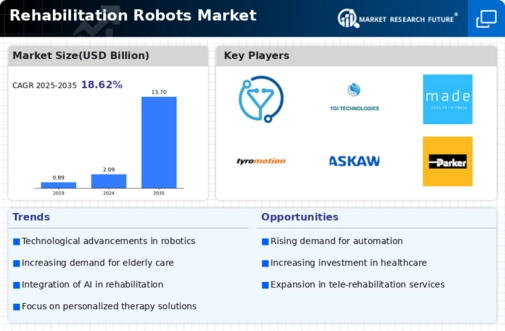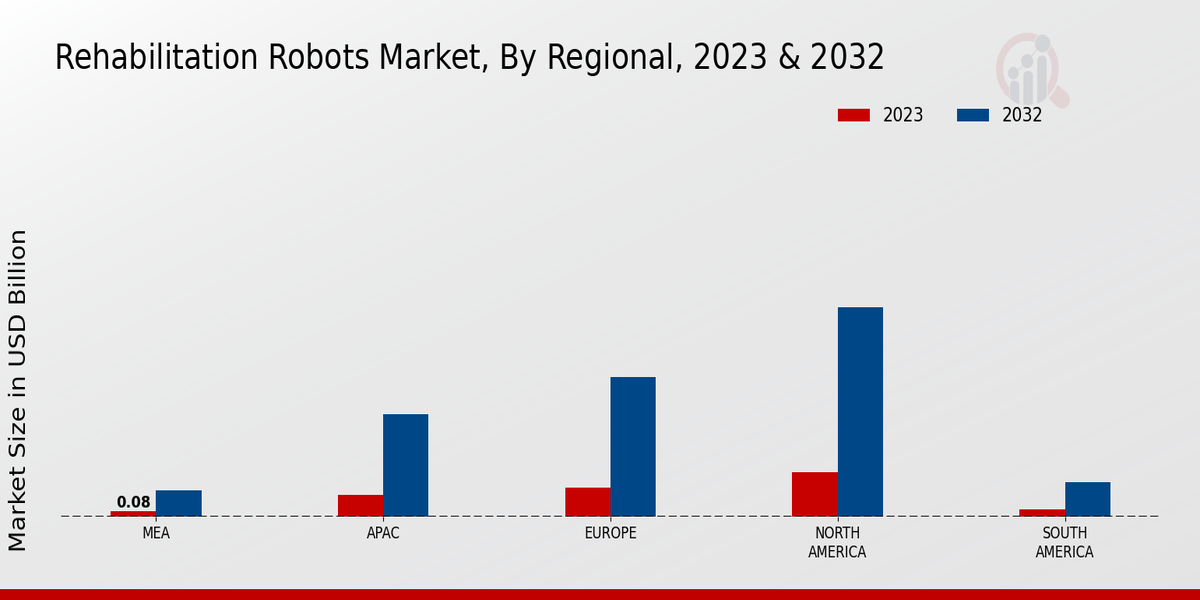Market Growth Projections
The Global Rehabilitation Robots Market Industry is projected to experience substantial growth in the coming years. With a market value of 2.09 USD Billion in 2024, it is expected to surge to 13.7 USD Billion by 2035. This remarkable growth trajectory indicates a compound annual growth rate (CAGR) of 18.6% from 2025 to 2035. Such projections reflect the increasing demand for rehabilitation solutions driven by an aging population, technological advancements, and rising chronic disease incidences. The market's expansion is likely to attract investments and innovations, further enhancing the capabilities and accessibility of rehabilitation robots globally.
Increasing Aging Population
The Global Rehabilitation Robots Market Industry is experiencing growth driven by the increasing aging population worldwide. As individuals age, they often face mobility challenges, leading to a higher demand for rehabilitation solutions. In 2024, the market is valued at 2.09 USD Billion, reflecting the urgent need for innovative technologies that assist the elderly in regaining mobility and independence. Countries with significant aging demographics, such as Japan and Germany, are investing heavily in rehabilitation robotics to enhance the quality of life for their senior citizens. This trend is expected to continue, with the market projected to reach 13.7 USD Billion by 2035.
Government Initiatives and Funding
Government initiatives and funding play a pivotal role in the growth of the Global Rehabilitation Robots Market Industry. Various countries are recognizing the importance of rehabilitation technologies in improving healthcare outcomes and are allocating resources to support research and development in this field. For example, government grants and subsidies are being provided to institutions that develop innovative rehabilitation robots. These initiatives not only foster innovation but also facilitate the integration of robotic solutions into healthcare systems. As governments prioritize healthcare advancements, the market is likely to benefit from increased investment and support, further driving its expansion.
Rising Incidence of Chronic Diseases
The rising incidence of chronic diseases is a critical driver of the Global Rehabilitation Robots Market Industry. Conditions such as stroke, arthritis, and neurological disorders necessitate rehabilitation interventions, which are increasingly being supported by robotic technologies. The integration of rehabilitation robots in clinical settings has shown promising results in improving recovery times and enhancing patient engagement. With the global burden of chronic diseases continuing to rise, healthcare systems are likely to adopt robotic rehabilitation solutions more widely. This trend underscores the potential for market expansion, as healthcare providers seek effective tools to manage the growing patient population.
Technological Advancements in Robotics
Technological advancements in robotics are propelling the Global Rehabilitation Robots Market Industry forward. Innovations in artificial intelligence, machine learning, and sensor technology are enhancing the capabilities of rehabilitation robots, making them more effective and user-friendly. For instance, robots equipped with advanced sensors can adapt to the specific needs of patients, providing personalized rehabilitation experiences. This technological evolution not only improves patient outcomes but also increases the efficiency of rehabilitation processes. As a result, the market is anticipated to grow at a CAGR of 18.6% from 2025 to 2035, indicating a robust future for rehabilitation robotics.
Growing Awareness of Rehabilitation Robotics
Growing awareness of rehabilitation robotics among healthcare professionals and patients is significantly influencing the Global Rehabilitation Robots Market Industry. As more practitioners recognize the benefits of robotic assistance in rehabilitation, there is a shift towards incorporating these technologies into treatment plans. Educational programs and workshops are being organized to inform healthcare providers about the advantages of rehabilitation robots, leading to increased adoption rates. This heightened awareness is expected to contribute to the market's growth trajectory, as patients become more informed about their options and seek out facilities that offer advanced rehabilitation solutions.





















